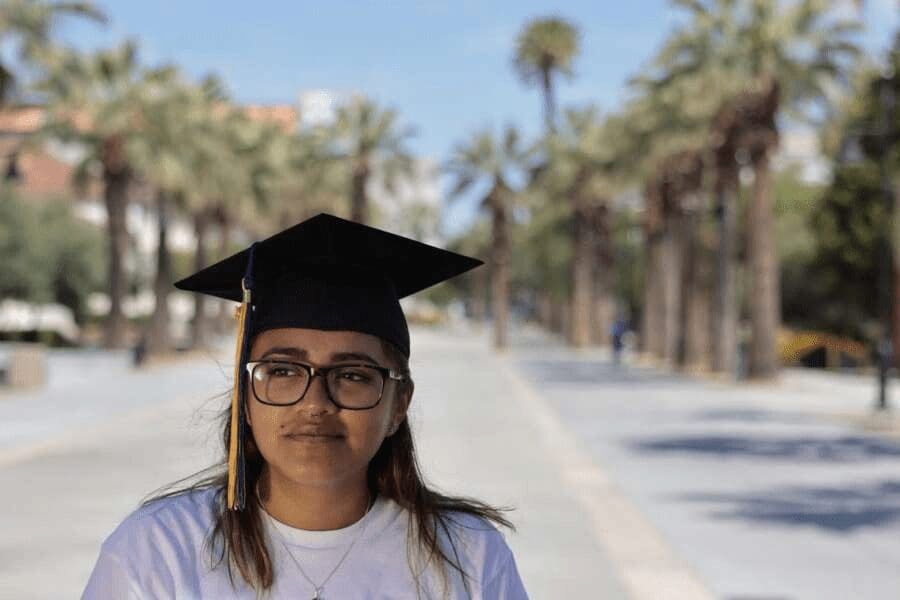By: Shwanika Narayan
Veronica Vieyra is no stranger to the bottom falling out.
After moving from Mexico when she was 9, Vieyra shared a cramped one-bedroom apartment in San Jose with her three younger brothers and a mother who worked several jobs in pursuit of the American dream. Then, in 2013, when Vieyra was 17, the unthinkable happened. Her mother was killed in a violent crime and the four children became wards of Santa Clara County’s foster care system.
“It was a horrible time, and I don’t even know if we properly grieved our mom,” Vieyra recalled. “It feels like we’ve been in survival mode for a while.”
Last year, Vieyra turned 24. That meant the oldest of the siblings had aged out of a foster system that provided her food, housing and some measure of stability in the wake of inexplicable loss. It was April 2020, and a global pandemic was exposing large gaps in the social safety net.
But then Santa Clara County did something unique. It created a universal basic income pilot program for aging-out foster youth such as Vieyra.
Since September, she and more than 70 other former foster youth ages 21 to 24 have received $1,000 a month along with financial mentoring.
The yearlong pilot program was supposed to sunset in August, but the Santa Clara County Board of Supervisors voted last month to extend it until February 2022 to collect more data.
Former supervisor and current state Sen. Dave Cortese, D-San Jose, proposed the local pilot program and is trying to take the concept statewide with SB739, which would send $1,000 monthly payments to 2,500 former foster youth for up to three years.
While Vieyra, now 25, said the program may have “literally saved her” from hurtling into a precarious housing situation, it’s unclear whether the once-controversial idea of guaranteed income — even for a population as disenfranchised as foster youth — can go mainstream.
‘These are our children’
In 2012, California extended the age when foster youth are no longer eligible for government services from 18 to 21. Santa Clara County extended it even further, to 24. But the transition from ward of the system to being completely on one’s own hasn’t gotten any easier, advocates and lawmakers say.
“Foster youth are an extraordinarily vulnerable population,” Cortese told The Chronicle. “We have a demographic that’s launched into independence whether they are ready for it or not the minute they hit a certain age. These are our children, and often they don’t have anywhere else to go for support on the first day of emancipation.”
One reason is that foster youth are much more likely to change schools than their peers, which has a cumulative impact on their academic trajectory, said Amy Lemley, the executive director of John Burton Advocates for Youth in San Francisco, a nonprofit advocating for foster and homeless youth.
“If you layer other issues, like coming from a low-income background, coupled with the lack of extended family support available to foster youth, you really have young people living in a very financially dangerous situation,” Lemley said.
That’s more obvious in Santa Clara County, which has one of the highest costs of living in the nation, Cortese said.
Pushed last year by Cortese when he was on the Board of Supervisors, Santa Clara County’s pilot program has now set aside $1.4 million for former foster youth. While the county doesn’t yet have formal figures to share about the program’s first 10 months, the person responsible for managing it said it has “provided much needed support at a critical time.”
“As a result of the assistance, many were able to avoid homelessness, or choose to get into school during shelter in place,” program manager Melanie Jimenez Perez added via email.
As for SB739, which carries an annual price tag of $30 million that Cortese and his sponsors propose comes from the state’s general fund, it passed the Senate and is awaiting a hearing date before the Assembly Appropriations Committee. That needs to happen by Aug. 27 for the bill to have a chance of reaching the governor’s desk.
On the local level, unconditional financial assistance is finding more elected officials willing to try it since former Stockton Mayor Michael Tubbs tested the concept in his city in 2019. Though researchers found that Stockton’s program significantly improved participants’ prospects of finding full-time employment and attaining financial stability, Tubbs lost his re-election bid the next year.
During the pandemic, San Francisco began basic-income programs for artists and pregnant Black and Pacific Islander women; Marin County announced one for women in March; and Oakland began accepting applications in June for a pilot program that seeks to serve 600 low-income families.
The fact that guaranteed income doesn’t proscribe how recipients spend the money has become both a target for the idea’s opponents and a critical selling point for its supporters.
“More than financial support, because (universal basic income) is unconditional and disbursed with no strings attached, it empowers young people to decide for themselves how to spend the money to meet their specific needs,” Gisèle Huff, president of the Gerald Huff Fund for Humanity, which partnered with Cortese on the Santa Clara County pilot program, said in a statement.
For Vieyra, the additional income meant the chance to achieve her mother’s dream.
A mother’s wish
After their mother died, Vieyra and her brothers had to deal with the additional fear of being separated. But all four found a temporary home in Redwood City, and eventually a more permanent foster home in San Jose, where Vieyra continued to pursue her education, just as her mom envisioned.
After three years at De Anza College, Vieyra transferred to San Jose State University. She worked as a nanny, took on internships, and received scholarships and financial aid during college. Living on her own since 2020, Vieyra used the money from the universal income pilot program toward rent and other basic necessities.
In May, she graduated with a bachelor’s degree in public health. She’s now looking to begin her career in the health care industry, and hoping to work with domestic violence survivors or young people navigating systems like foster care.
One of her brothers attends Cal State Chico, where his housing is taken care of, while two of her brothers are still with the foster family that took them in in 2013. Except for the youngest, who was born in the United States, three of the siblings are in the process of obtaining their citizenship. Sometimes they venture to Casa de Fruta, a fruit orchard in Hollister (San Benito County) that their mother used to take them to. It has a huge fruit stand, children’s rides and a duck pond that visitors drop their wishes into.
When Vieyra graduated from college, fulfilling her mother’s greatest wish, she said she wanted to express so much. But the only thought that came to her as she crossed the stage to receive her degree was, “This is for you, Mom.”
______________________________________
About the Author: Shwanika Narayan is a San Francisco Chronicle staff writer. Email: shwanika.narayan@sfchronicle.com Twitter and Instagram: @shwanika





















